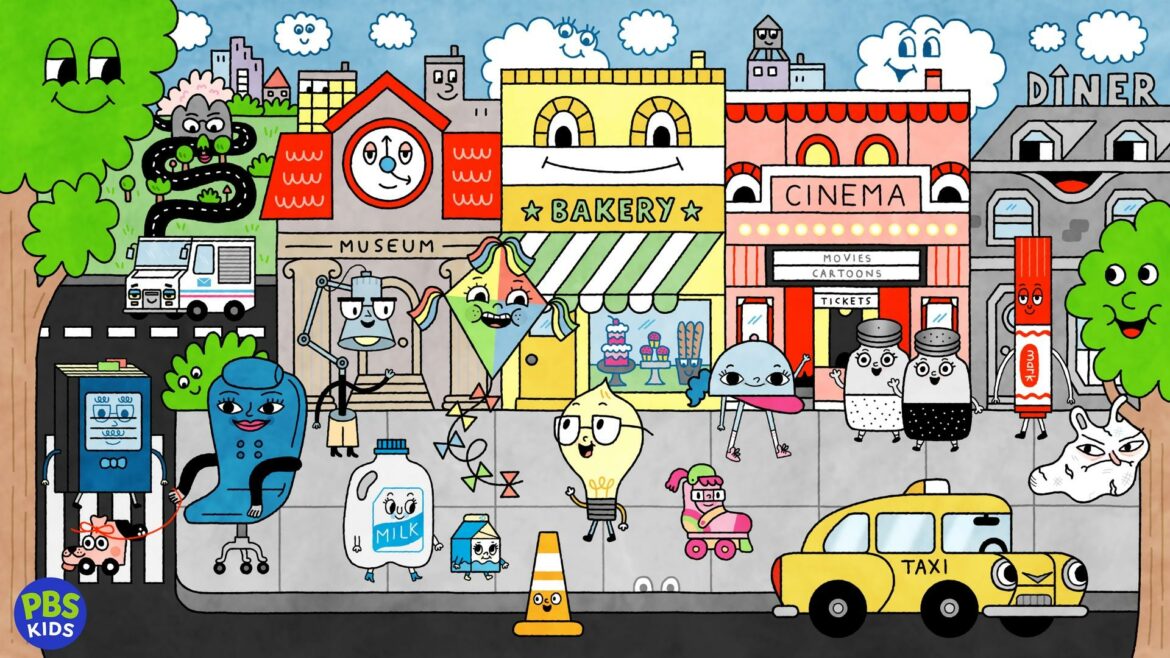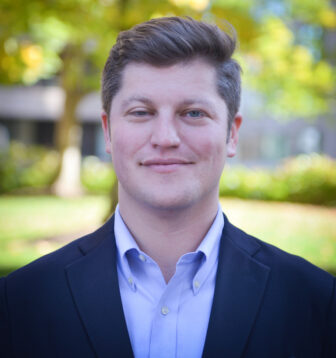With ‘City Island,’ PBS Kids leans into animated shorts to show how communities work

PBS
"City Island," a series of animated shorts created by Aaron Augenblick, debuted in December 2022.
On City Island, everything is alive, from the girders on a newly constructed building to the snowplow cleaning up the streets. Sleepy-eyed markers wander past talking houses, while a little know-it-all lightbulb named Watt debates his best friend, a kite named Windy whose tassel pigtails blow in the breeze.
It’s a wondrous place where each piece of the community is not only sentient, but also thoughtful. Everyone works together to make their neighborhood the best possible place to live, whether that’s through the launch of a new communal garden or a reminder that a whole lot of people — or talking objects, in this case — have to work together to construct just one building.
Charmingly crafted and created by animator Aaron Augenblick (Wonder Showzen, Ugly Americans), City Island was inspired by Augenblick’s love of the wacko worlds brought to life in shows like Pee-Wee’s Playhouse and old Betty Boop cartoons with talking windows and taxi cabs. It was also inspired by Sesame Street, which emitted a sense of joyful community that Augenblick glommed onto as a child.

“I created City Island in part as an homage to Sesame Street because I’ve always liked the idea that, in any episode, kids can … meet all these different people in a location that’s friendly, inviting, and seems like it would be really fun to hang out in,” Augenblick said.
Those Sesame Street vibes are part of what landed City Island at PBS Kids. Aimed at elementary school kids, the short-form show debuted in December as interstitial content, airing between episodes of long-form programs. With new shorts that arrived Monday, the series has now delivered 20 three-minute episodes.
The series is undoubtedly fresh and distinct, and its brief runtime is a relatively new format for PBS Kids. Tommy Gillespie, senior director of current series, said the network sees “a lot of opportunities” in the short-form space, including a chance to teach topics that might not work as well as what he calls “a traditional bread-and-butter half-hour series.”
Helping kids understand their communities
Like Sesame Street, City Island pays tribute not just to New York City but to all the different kinds of people who make up its neighborhoods, Gillespie says. “I think that’s something that’s going to resonate with kids whether they live in a city or in a more rural or suburban environment,” he said. “The show captures community so well, and that’s something that we really responded to when we were working on it.”
Augenblick always envisioned City Island as educational. But when he first brought it to PBS Kids, it was a show about problem-solving — hence the little lightbulb with big ideas. Once he started working with the PBS Kids team, they realized the show would be a good fit for the network’s push toward increased civics awareness for kids.
“Kids this age are beginning to understand their place in the world, their place in the community, and have lots of questions about ‘Where do I fit in in terms of all this incredible stuff that’s going around around me?’” Gillespie said. “City Island can demystify some of that for kids and give them the opportunity to understand their role and responsibility as a member of their own community.”
Augenblick says he dove headfirst into re-learning about civics when he was crafting the show, coming to understand that the subject encompasses more than government. It includes topics like finance, transportation and infrastructure management. He teamed with educational advisor Elizabeth Hinde, dean of the School of Education at Metropolitan State University in Denver, who penned the civics curriculum for PBS Kids.
“I started having conversations with Liz about civics and social studies, and … all of our conversations would inspire episode ideas,” Augenblick said. “She would tell me [about] some simple concept in civics, like the idea of geography. … She’d say, ‘Geography to a kid is just the idea that there’s a world much bigger than the world that’s right in front of you. Your house is inside a town and that town is inside a country, and that country is inside a world. That’s civics.’”
That conversation then inspired “The World,” an episode where Watt and Windy’s class visits the planetarium. A GPS satellite gives a presentation by zooming in and out on City Island. That’s also where they meet Terra, the planet City Island sits on. The character is voiced by Amy Schumer, one of many special guest voices recruited to join the City Island gang. The show also called in marquee talent when crafting its theme music, enlisting TV On The Radio’s Tunde Adebimpe to craft its uber-catchy intro.
“There’s never been a more important time to express the importance of kindness and collaboration than right now,” Augenblick said. “The worst thing that we see is division between people. … Being able to do a show that talks about people that enjoy each other’s company and are working towards a productive society is important.”
Growing library of animated shorts
With its three-minute format, City Island doesn’t fit into PBS Kids’ traditional portfolio of long-form animation programming. Instead, it joins a growing library of what a PBS press release describes as “fun and engaging shorts.” Additional animated shorts include Molly of Denali: The Big Gathering, which debuted in November, and Jelly, Ben & Pogo, a series from Jalysa Leva about a pair of Filipino-American siblings and their sea monster friend.

“We want to be everywhere kids are, and short-form content is a really exciting area that we’re really leaning into,” Gillespie said. “Some of these bite-sized chunks are perfect for kids that are watching on streaming platforms, but we also use them on our linear platforms and broadcast to make every minute of the half-hour show that a kid might be watching on their local PBS station as engaging as possible.”
These days, how kids watch TV differs wildly from adults who grew up tuned to broadcast and cable TV channels. Kids increasingly choose to watch their favorite shows via on-demand platforms like YouTube. In fact, that’s happening with kids’ consumption of PBS content. During a calendar year, about 10.4 million kids between ages 2 and 8 watch broadcasts of PBS stations, according to Nielsen data provided by PBS.
Across all digital platforms for PBS Kids — including video streaming and games on its website, mobile and over-the-top apps — total monthly usage averages 15.4 million viewers, according to PBS. This metric includes some duplication across different devices and platforms. The PBS Kids YouTube channel, which tends to feature shorter clips from its shows, averages about 28.9 million unique views per month.
“We know that there are moments in a kid’s day when a shorter format can really work well and be there on demand to fit into their busy schedules,” Gillespie said. “Part of our emphasis and focus on shorts and the different opportunities that they bring is to fill that desire.”
Augenblick hails PBS Kids’ move into short-form content as building its multiplatform capacity and audience. “Because [the show] is only three minutes, people are easily watching on their phones or watching on apps or watching on TV,” he said. “They’re watching everywhere, so [PBS is] getting a whole new audience for the show that they wouldn’t have gotten if it was much longer.”
Gillespie wants to see City Island expand further. “It’s such a rich world,” he said. “We’d love to explore new opportunities for storytelling with Aaron, like [with] interactivity and the gaming space. You look at that city and you really want to jump in and play it yourself.”
As for Augenblick, he’s up for anything. “I could make this show forever,” he said. “There are so many places that I still want to explore and it’s one of the most fruitful ideas that I’ve ever had. … I don’t see any limit to the number of stories that we can tell.”






